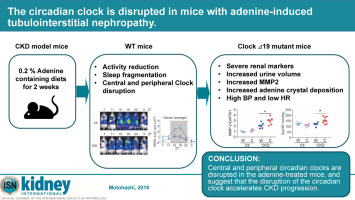当前位置:
X-MOL 学术
›
Kidney Int.
›
论文详情
Our official English website, www.x-mol.net, welcomes your
feedback! (Note: you will need to create a separate account there.)
The circadian clock is disrupted in mice with adenine-induced tubulointerstitial nephropathy.
Kidney International ( IF 14.8 ) Pub Date : 2020-01-09 , DOI: 10.1016/j.kint.2019.09.032 Hiroaki Motohashi 1 , Yu Tahara 2 , Daniel S Whittaker 3 , Huei-Bin Wang 3 , Takahiro Yamaji 4 , Hiromichi Wakui 4 , Atsushi Haraguchi 1 , Mayu Yamazaki 1 , Hiroki Miyakawa 1 , Koki Hama 1 , Hiroyuki Sasaki 1 , Tomoko Sakai 1 , Rina Hirooka 1 , Kengo Takahashi 1 , Miku Takizawa 1 , Saneyuki Makino 1 , Shinya Aoyama 1 , Christopher S Colwell 3 , Shigenobu Shibata 1
Kidney International ( IF 14.8 ) Pub Date : 2020-01-09 , DOI: 10.1016/j.kint.2019.09.032 Hiroaki Motohashi 1 , Yu Tahara 2 , Daniel S Whittaker 3 , Huei-Bin Wang 3 , Takahiro Yamaji 4 , Hiromichi Wakui 4 , Atsushi Haraguchi 1 , Mayu Yamazaki 1 , Hiroki Miyakawa 1 , Koki Hama 1 , Hiroyuki Sasaki 1 , Tomoko Sakai 1 , Rina Hirooka 1 , Kengo Takahashi 1 , Miku Takizawa 1 , Saneyuki Makino 1 , Shinya Aoyama 1 , Christopher S Colwell 3 , Shigenobu Shibata 1
Affiliation

|
Chronic Kidney Disease (CKD) is increasing in incidence and has become a worldwide health problem. Sleep disorders are prevalent in patients with CKD raising the possibility that these patients have a disorganized circadian timing system. Here, we examined the effect of adenine-induced tubulointerstitial nephropathy on the circadian system in mice. Compared to controls, adenine-treated mice showed serum biochemistry evidence of CKD as well as increased kidney expression of inflammation and fibrosis markers. Mice with CKD exhibited fragmented sleep behavior and locomotor activity, with lower degrees of cage activity compared to mice without CKD. On a molecular level, mice with CKD exhibited low amplitude rhythms in their central circadian clock as measured by bioluminescence in slices of the suprachiasmatic nucleus of PERIOD 2::LUCIFERASE mice. Whole animal imaging indicated that adenine treated mice also exhibited dampened oscillations in intact kidney, liver, and submandibular gland. Consistently, dampened circadian oscillations were observed in several circadian clock genes and clock-controlled genes in the kidney of the mice with CKD. Finally, mice with a genetically disrupted circadian clock (Clock mutants) were treated with adenine and compared to wild type control mice. The treatment evoked worse kidney damage as indicated by higher deposition of gelatinases (matrix metalloproteinase-2 and 9) and adenine metabolites in the kidney. Adenine also caused non-dipping hypertension and lower heart rate. Thus, our data indicate that central and peripheral circadian clocks are disrupted in the adenine-treated mice, and suggest that the disruption of the circadian clock accelerates CKD progression.
中文翻译:

患有腺嘌呤诱导的肾小管间质性肾病的小鼠的昼夜节律被打乱。
慢性肾脏病(CKD)的发病率正在增加,已成为世界范围内的健康问题。睡眠障碍在CKD患者中普遍存在,从而增加了这些患者的生理昼夜节律系统混乱的可能性。在这里,我们检查了腺嘌呤诱导的肾小管间质性肾病对小鼠昼夜节律系统的影响。与对照相比,经腺嘌呤治疗的小鼠显示出CKD的血清生化证据以及肾脏炎症和纤维化标记物表达增加。与没有CKD的小鼠相比,具有CKD的小鼠表现出支离破碎的睡眠行为和运动活动,笼式活动程度较低。在分子水平上,CKD小鼠在其中央昼夜节律时钟中表现出低振幅节律,这是通过PERIOD 2 :: LUCIFERASE小鼠视交叉上核的切片中的生物发光测定的。整个动物的影像显示,腺嘌呤治疗的小鼠在完整的肾脏,肝脏和下颌下腺中也表现出减弱的振荡。一致地,在患有CKD的小鼠的肾脏中,在几个昼夜节律时钟基因和时钟控制基因中观察到了节律性昼夜节律振荡。最后,将具有遗传性昼夜节律时钟的小鼠(Clock突变体)用腺嘌呤处理,并与野生型对照小鼠进行比较。如明胶酶(基质金属蛋白酶2和9)和腺嘌呤代谢产物在肾脏中的沉积较高,该治疗引起了更严重的肾脏损害。腺嘌呤还引起非浸润性高血压并降低心率。因此,我们的数据表明,在腺嘌呤治疗的小鼠中,中枢和外周昼夜节律被破坏,
更新日期:2020-01-13
中文翻译:

患有腺嘌呤诱导的肾小管间质性肾病的小鼠的昼夜节律被打乱。
慢性肾脏病(CKD)的发病率正在增加,已成为世界范围内的健康问题。睡眠障碍在CKD患者中普遍存在,从而增加了这些患者的生理昼夜节律系统混乱的可能性。在这里,我们检查了腺嘌呤诱导的肾小管间质性肾病对小鼠昼夜节律系统的影响。与对照相比,经腺嘌呤治疗的小鼠显示出CKD的血清生化证据以及肾脏炎症和纤维化标记物表达增加。与没有CKD的小鼠相比,具有CKD的小鼠表现出支离破碎的睡眠行为和运动活动,笼式活动程度较低。在分子水平上,CKD小鼠在其中央昼夜节律时钟中表现出低振幅节律,这是通过PERIOD 2 :: LUCIFERASE小鼠视交叉上核的切片中的生物发光测定的。整个动物的影像显示,腺嘌呤治疗的小鼠在完整的肾脏,肝脏和下颌下腺中也表现出减弱的振荡。一致地,在患有CKD的小鼠的肾脏中,在几个昼夜节律时钟基因和时钟控制基因中观察到了节律性昼夜节律振荡。最后,将具有遗传性昼夜节律时钟的小鼠(Clock突变体)用腺嘌呤处理,并与野生型对照小鼠进行比较。如明胶酶(基质金属蛋白酶2和9)和腺嘌呤代谢产物在肾脏中的沉积较高,该治疗引起了更严重的肾脏损害。腺嘌呤还引起非浸润性高血压并降低心率。因此,我们的数据表明,在腺嘌呤治疗的小鼠中,中枢和外周昼夜节律被破坏,











































 京公网安备 11010802027423号
京公网安备 11010802027423号